(Photo: An installation about Ona Judge, often referred to by the diminutive Oney, in the exhibition “Lives Bound Together: Slavery at George Washington’s Mount Vernon.” Credit Justin T. Gellerson for The New York Times)
In Search of the Slave Who Defied George Washington
The costumed characters at George Washington’s gracious estate here are used to handling all manner of awkward queries, whether about 18th-century privies or the first president’s teeth. So when a visitor recently asked an African-American re-enactor in a full skirt and head scarf if she knew Ona Judge, the woman didn’t miss a beat.
Judge’s escape from the presidential residence in Philadelphia in 1796 had been “a great embarrassment to General and Lady Washington,” the woman said, before offering her own view of the matter.
“Ona was born free, like everybody,” she said. “It was this world that made her a slave.”
It’s always 1799 at Mount Vernon, where more than a million visitors annually see the property as it was just before Washington’s death, when his will famously freed all 123 of his slaves. That liberation did not apply to Ona Judge, one of 153 slaves held by Martha Washington.
But Judge, it turned out, evaded the Washingtons’ dogged (and sometimes illegal) efforts to recapture her, and would live quietly in New Hampshire for another 50 years. Now her story — and the challenge it offers to the notion that Washington somehow transcended the seamy reality of slaveholding — is having its fullest airing yet. (read more)
U. of Texas’ first black undergraduates tell their stories
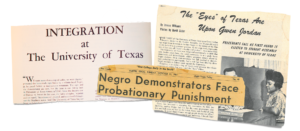 (Alcalde) On a Thursday night in September, about 50 black alumni, UT staff, and community members file into the Alumni Center’s Connally Ballroom for a panel discussion titled “Then and Now.” The atmosphere is casual, with friends hugging and chatting about the football team’s big win over Notre Dame the previous weekend; a young mom bounces a smiling baby on her shoulder. The room falls silent, though, when four people rise and begin walking toward the front of the room.
(Alcalde) On a Thursday night in September, about 50 black alumni, UT staff, and community members file into the Alumni Center’s Connally Ballroom for a panel discussion titled “Then and Now.” The atmosphere is casual, with friends hugging and chatting about the football team’s big win over Notre Dame the previous weekend; a young mom bounces a smiling baby on her shoulder. The room falls silent, though, when four people rise and begin walking toward the front of the room.
Charles Miles, Mamie Ewing, Leon Holland, and Willie Jordan are impeccably dressed. Now in their 80s, they walk slowly and deliberately to take their seats onstage. Lori Lewis-Conerly, MSW ’06, Life Member, past chair of the Texas Exes Black Alumni Network, introduces them, saying simply, “I am here because of you.”
Over the next hour, the four share their memories of what it was like to be among the Precursors—the first black undergraduate students to enroll at UT-Austin in 1956. As wide-eyed teenagers and 20-somethings, they arrived just one year after Emmett Till was lynched in Mississippi. The civil rights movement was in its infancy, and Martin Luther King Jr. wouldn’t give his “I Have a Dream” speech for another seven years. Although the Supreme Court’s ruling in Brown v. Board of Education had mandated that public schools desegregate two years earlier, the pace of change was glacial. Classrooms were virtually the only place on the UT campus where black students could go, with dormitories, student organizations, sports teams, and nearby businesses all still separated by race.
Miles, Ewing, Holland, and Jordan talk about peers who hurled racial epithets, professors who refused to call on them in class, and the difficulty of finding a place to eat dinner when all the restaurants surrounding the campus were whites-only. They also talk about forming lifelong friendships, discovering new interests and careers, and finding allies in unexpected places. And they nod in recognition when Calep Smith, a 20-year-old junior studying corporate communication, describes what it’s like to be black on the Forty Acres today. “You feel like you have to mask yourself,” Smith says. “You don’t want to be seen as ‘too black,’ but you also don’t want to cover it up too much. It can get lonely.”
At the end of the evening, someone asks if there are any black UT freshmen in the audience. Two young women stand and smile shyly. The applause is thunderous, and as the generations regard each other from across the room, 60 years of history are suddenly made visible. (read more, watch video, “First Black Undergraduates at UT-Austin)
HBCU Hall of Fame Players Honored at Super Bowl
Elite NFL players who graduated from a historically Black college or university, and made history when going pro, were recognized in pre-game ceremonies
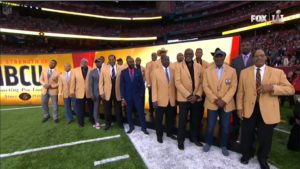 The National Football League honored Pro Football Hall of Fame players from Historically Black Colleges and Universities before the start of Super Bowl LI between the Atlanta Falcons and the New England Patriots in Houston.
The National Football League honored Pro Football Hall of Fame players from Historically Black Colleges and Universities before the start of Super Bowl LI between the Atlanta Falcons and the New England Patriots in Houston.
Following an almost year-long partnership between the Black College Football Hall of Fame and the Pro Football Hall of Fame, the NFL “reached out with the great concept of shining a light on the Historically Black Colleges and Universities by introducing those HBCUs Gold Jackets at Super Bowl LI,” PFHOF President and CEO Dave Baker said in a statement.
Of the 303 members of the PFHOF, 29 attended HBCUs. Grambling State University President Rick Gallot said in an interview that the amount of hall of famers that graduated from HBCUs highlights “the importance of HBCUs and how we have played a significant role in producing some of the greatest players to ever put on a helmet and shoulder pads.” (read more, watch video of the ceremonies)
African American Texas History Made Plain — An after work teaching and networking event
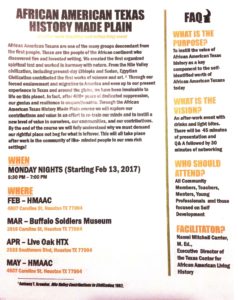 African American Texans are one of the many groups descendant from the first people. These are the people of the African continent who discovered fire and invented writing. Africans created the first organized spiritual text and worked in harmony with nature. From the Nile Valley civilization, including present-day Ethiopia and Sudan, Egyptian Civilization contribute the first works of science and art. Through our forced enslavement and migration to America and even up to our present experience in Texas and around the globe, Africans have been invaluable to life on this planet. In fact, after 400-plus years of dedicated suppression, their genius and resilience is unquestionable.
African American Texans are one of the many groups descendant from the first people. These are the people of the African continent who discovered fire and invented writing. Africans created the first organized spiritual text and worked in harmony with nature. From the Nile Valley civilization, including present-day Ethiopia and Sudan, Egyptian Civilization contribute the first works of science and art. Through our forced enslavement and migration to America and even up to our present experience in Texas and around the globe, Africans have been invaluable to life on this planet. In fact, after 400-plus years of dedicated suppression, their genius and resilience is unquestionable.
“The African American Texas History Made Plain will explore our contributions and value in an effort to re-train our minds and to instill a new level of value in ourselves, our communities, and our contributions,” said Naomi Mitchell Carrier, M.Ed., course facilitator and executive director, the Texas Center for African American Living History. “By the end of the course, we will fully understand why we must demand our rightful place not beg for what is leftover.”
The meetings, spread over several Mondays from February to May, will all take place from 5:30 to 7 p.m. at various locations beginning Feb. 13. For more information, click on flyer image above to enlarge.
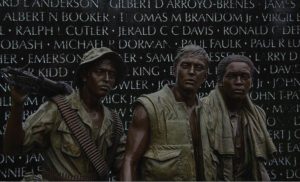 Correction: In last week’s edition, the item “Vietnam Memorial Wall: Putting a face to every name,” mentioned the project’s volunteer team leader, Janna Hoehn had uncovered 4,000 photos of Texas veteran’s inscribed on the wall. The 4,000 photos she has collected are from several states since 2011. There were just under 1,200 photos needed when she started collecting images for Texas names and that total is now down to 182. For more information on the project and how you can help, see the project’s web site, The Wall of Faces, or contact Ms. Hoehn at neverforgotten2014@gmail.com.
Correction: In last week’s edition, the item “Vietnam Memorial Wall: Putting a face to every name,” mentioned the project’s volunteer team leader, Janna Hoehn had uncovered 4,000 photos of Texas veteran’s inscribed on the wall. The 4,000 photos she has collected are from several states since 2011. There were just under 1,200 photos needed when she started collecting images for Texas names and that total is now down to 182. For more information on the project and how you can help, see the project’s web site, The Wall of Faces, or contact Ms. Hoehn at neverforgotten2014@gmail.com.
TIPHC Bookshelf
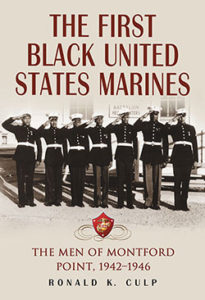 Published scholarship on black history in Texas is growing and we’d like to share with you some suggested readings, both current and past, from some of the preeminent history scholars in Texas and beyond. We invite you to take a look at our bookshelf page — including a featured selection — and check back as the list grows. A different selection will be featured each week. We welcome suggestions and reviews. This week, we offer, “The First Black United States Marines: The Men of Montford Point, 1942-1946,” by Ronald K. Culp.
Published scholarship on black history in Texas is growing and we’d like to share with you some suggested readings, both current and past, from some of the preeminent history scholars in Texas and beyond. We invite you to take a look at our bookshelf page — including a featured selection — and check back as the list grows. A different selection will be featured each week. We welcome suggestions and reviews. This week, we offer, “The First Black United States Marines: The Men of Montford Point, 1942-1946,” by Ronald K. Culp.
On June 1, 1942, the United States Marine Corps broke a 144-year tradition and enlisted the first black Marines — including Palestine, Texas native Alfred Masters. Three months later, more than 400 black volunteers began their training as members of the 51st Composite Defense Battalion at Montford Point, a Marine camp of over five square miles located within Camp Lejeune in North Carolina. Informed by personal interviews, this volume takes an in-depth look at the men who braved the color barrier and became the first black Marines.
Beginning with a look at the pre–World War II Marine Corps, it examines the creed and contemporary image of the USMC. The main focus is the experiences of the new black Marines. Additional topics include internal Marine perspectives on the admittance of blacks, initially enforced quotas, and the difficulties of segregation. Appendices provide information regarding monthly inductions into the Marine Corps from 1941 to 1945; rank and pay structure; depot and ammunition companies from 1943 to 1946; and Pacific Ocean area units of fire for ground weapons.
This Week In Texas Black History, Feb. 5-11
5 – On this day in 1840, the Congress of the Republic of Texas passed the Law of February 5. Though there were relatively few free blacks in the republic, legislators concerned over the status of slavery attempted to restrict further the number of free blacks. The law declared that all free blacks who had entered Texas after the Texas Declaration of Independence must leave the republic within two years or be declared slaves for the rest of their lives. Those free blacks who were already in the republic before Texas independence would continue to have all the rights of their white neighbors. Provisions were made for free blacks who entered later to petition the Congress for exception.
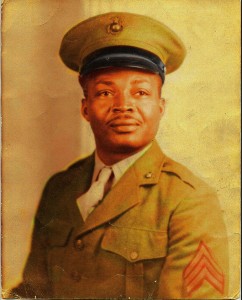 5 – Alfred Masters, the first African American sworn into the U. S. Marine Corps, was born on this day 1916 in Palestine, Texas. Masters was sworn into the marines June 1, 1942. After his swearing in, he trained at Montford Point, North Carolina where other African Americans were later trained (now known as the Montford Point Marines). Masters eventually rose to the rank of technical sergeant.
5 – Alfred Masters, the first African American sworn into the U. S. Marine Corps, was born on this day 1916 in Palestine, Texas. Masters was sworn into the marines June 1, 1942. After his swearing in, he trained at Montford Point, North Carolina where other African Americans were later trained (now known as the Montford Point Marines). Masters eventually rose to the rank of technical sergeant.
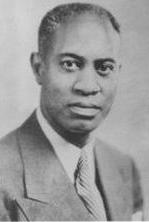 6 – Melvin Tolson, writer, educator, and poet, was born on this day in 1898 in Moberly, Missouri. A graduate of Lincoln (Mo.) University, Tolson began teaching speech and English at Wiley College in 1924. His award-winning debate team, which in 1935 beat the reigning national champion from the University of Southern California, had a 10-year winning steak between 1929 and 1939. Tolson also mentored students such as James L. Farmer, Jr. and Heman Sweatt. In 2007, his story and his team were portrayed in the film, “The Great Debaters.”
6 – Melvin Tolson, writer, educator, and poet, was born on this day in 1898 in Moberly, Missouri. A graduate of Lincoln (Mo.) University, Tolson began teaching speech and English at Wiley College in 1924. His award-winning debate team, which in 1935 beat the reigning national champion from the University of Southern California, had a 10-year winning steak between 1929 and 1939. Tolson also mentored students such as James L. Farmer, Jr. and Heman Sweatt. In 2007, his story and his team were portrayed in the film, “The Great Debaters.”
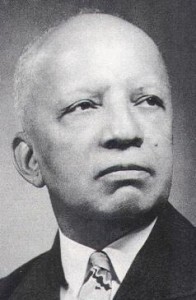 7 – On this date in 1926, historian Dr. Carter G. Woodson, the son of illiterate slaves, initiated the first National Negro Week. In 1972, it was renamed Black History Week and in 1976, it became Black History Month. Said Woodson: “Those who have no record of what their forebears have accomplished lose the inspiration which comes from the teaching of biography and history.”
7 – On this date in 1926, historian Dr. Carter G. Woodson, the son of illiterate slaves, initiated the first National Negro Week. In 1972, it was renamed Black History Week and in 1976, it became Black History Month. Said Woodson: “Those who have no record of what their forebears have accomplished lose the inspiration which comes from the teaching of biography and history.”
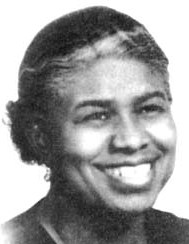 9 – On this date in 1902, civil rights activist Juanita Craft was born in Round Rock. She worked as a maid in Dallas at the Adolphus Hotel from 1925-1934 before joining the Dallas branch of the NAACP in 1935 and beginning several decades of service. She helped organize 182 branches of the NAACP in Texas and in 1944 was the first black woman in Dallas County to vote. In 1946 she was the first black woman deputized in the state to collect the poll tax. Craft also served two terms on the Dallas City Council (1975-1979).
9 – On this date in 1902, civil rights activist Juanita Craft was born in Round Rock. She worked as a maid in Dallas at the Adolphus Hotel from 1925-1934 before joining the Dallas branch of the NAACP in 1935 and beginning several decades of service. She helped organize 182 branches of the NAACP in Texas and in 1944 was the first black woman in Dallas County to vote. In 1946 she was the first black woman deputized in the state to collect the poll tax. Craft also served two terms on the Dallas City Council (1975-1979).
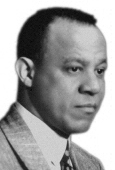 9 – Dr. Lawrence Nixon was born on this day in 1883 in Marshall. Nixon had a successful practice in El Paso where he was a charter member of the city’s branch of the NAACP. In 1923, Nixon challenged a state law that barred African Americans from participating in the Texas Democratic Party’s white’s only electoral primaries. Nixon won two U.S. Supreme Court rulings making the primaries unconstitutional. However, it would be another 20 years before the white primary would finally be abolished.
9 – Dr. Lawrence Nixon was born on this day in 1883 in Marshall. Nixon had a successful practice in El Paso where he was a charter member of the city’s branch of the NAACP. In 1923, Nixon challenged a state law that barred African Americans from participating in the Texas Democratic Party’s white’s only electoral primaries. Nixon won two U.S. Supreme Court rulings making the primaries unconstitutional. However, it would be another 20 years before the white primary would finally be abolished.
Blog: Ron Goodwin, author, PVAMU history professor
 Ron Goodwin’s bi-weekly blog appears exclusively for TIPHC. Goodwin is a San Antonio native and Air Force veteran. Generally, his column addresses contemporary issues in the black community and how they relate to black history. He and the TIPHC staff welcome your comments.
Ron Goodwin’s bi-weekly blog appears exclusively for TIPHC. Goodwin is a San Antonio native and Air Force veteran. Generally, his column addresses contemporary issues in the black community and how they relate to black history. He and the TIPHC staff welcome your comments.
Read his latest entry, “To Tell the Truth,” here.
Submissions Wanted
Historians, scholars, students, lend us your…writings. Help us produce the most comprehensive documentation ever undertaken for the African American experience in Texas. We encourage you to contribute items about people, places, events, issues, politics/legislation, sports, entertainment, religion, etc., as general entries or essays. Our documentation is wide-ranging and diverse, and you may research and write about the subject of your interest or, to start, please consult our list of suggested biographical entries and see submission guidelines. However, all topics must be approved by TIPHC editors before beginning your research/writing.
We welcome your questions or comments via email or telephone – mdhurd@pvamu.edu.
